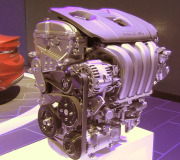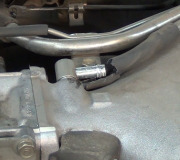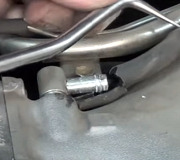I do not see the image. It sounds like you have low fuel pressure but to be sure please follow this guide, you can rent a fuel pressure gauge from the auto parts store for cheap or free.
https://www.2carpros.com/articles/how-to-check-fuel-system-pressure-and-regulator
Key On Engine Off 35 - 45 psi
Key On Engine Running 30 - 40 psi
If the pump is bad make sure you drain the fuel from it before removal.
https://youtu.be/Q5MH2gnyFH0
Based on the symptoms you described, it appears that your 1996 Ford Ranger is experiencing a significant issue with its engine performance. Here are some steps you can take to troubleshoot and potentially resolve the problem:
Check for Diagnostic Trouble Codes (DTCs): Use an OBD-II scanner to check for any diagnostic trouble codes stored in the engine control module (ECM). These codes can provide valuable insights into the specific issues the engine is experiencing.
Inspect the Mass Air Flow (MAF) Sensor: If the MAF sensor is damaged or faulty, it can cause rough idling and poor acceleration. Inspect the sensor for any visible damage or contamination and consider cleaning or replacing it if necessary.
Check for Vacuum Leaks: Vacuum leaks can disrupt the air-fuel mixture and cause rough idling. Inspect all vacuum hoses, connections, and intake manifold gaskets for leaks.
Inspect the Ignition System: Problems with the ignition system, such as faulty spark plugs, ignition coils, or spark plug wires, can cause rough running and stalling. Check these components and replace any that appear worn or damaged.
Test the Fuel Pressure: Even though you mentioned that the fuel pump and fuel filter are new, it's still worth checking the fuel pressure to ensure it is within the correct range.
Examine the Exhaust System: A clogged catalytic converter or exhaust system can restrict airflow and cause engine performance issues. Inspect the exhaust system for any blockages.
Review the Condition of the Fuse Box: If the fuse box looks damaged or has melted components, it's possible that there was an electrical issue. Investigate and repair any damaged wiring or fuse-related problems.
Check the Idle Air Control (IAC) Valve: The IAC valve controls the engine's idle speed. A malfunctioning IAC valve can cause rough idling. Ensure it is clean and functioning correctly.
Verify the Throttle Position Sensor (TPS): The TPS provides crucial input to the ECM about the throttle position. A faulty TPS can cause stalling and rough idling. Test or replace it if needed.
Look for Water or Contaminated Fuel: Since the truck has been sitting for a year, there's a possibility of water or contamination in the fuel tank. Ensure the fuel you used is clean and free from impurities.
Given the history of the truck sitting idle for a year, it's possible that several issues have arisen due to long-term inactivity. Thoroughly inspecting and testing these various components should help identify the underlying problems and get your Ford Ranger running smoothly again. However, if you are unsure about performing these troubleshooting steps yourself
Check out the images (below). Let us know what happens and please upload pictures or videos of the problem so we can see what's going on.
Images (Click to make bigger)
Tuesday, August 1st, 2023 AT 11:53 AM







